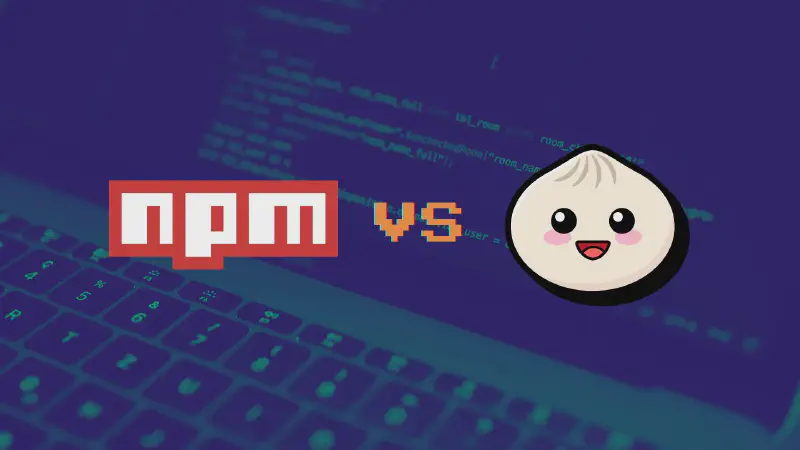As a JavaScript developer, you’re likely familiar with the importance of package managers in your workflow. Two popular options, NPM (Node Package Manager) and Bun, have been gaining traction in recent years. While both tools share some similarities, they have distinct differences that can impact your development experience.
In this article, we’ll delve into a comprehensive comparison of NPM and Bun, helping you decide which package manager is best suited for your project.
What is NPM?
 NPM (Node Package Manager) stands for Node Package Manager and is the world’s largest software registry for JavaScript packages. It allows developers to easily install, manage, and share open-source modules and packages.
NPM (Node Package Manager) stands for Node Package Manager and is the world’s largest software registry for JavaScript packages. It allows developers to easily install, manage, and share open-source modules and packages.
Key Features of NPM
- Extensive Package Registry: NPM hosts the largest collection of open-source packages, offering a wide range of libraries and tools.
- Dependency Management: NPM efficiently manages project dependencies and allows for semantic versioning.
- Script Automation: NPM scripts enable automation of tasks like testing, building, and deploying projects.
- Wide Adoption: NPM’s long-standing presence means extensive community support and documentation.
What is Bun?
 Bun, a JavaScript runtime and package manager developed by V8 engineers. Bun was announced in 2022 by the V8 team, which is the same team behind Node.js and Google Chrome’s JavaScript engine. The primary goal of Bun is to provide a faster, more efficient, and more secure alternative to existing JavaScript runtimes like Node.js.
Bun, a JavaScript runtime and package manager developed by V8 engineers. Bun was announced in 2022 by the V8 team, which is the same team behind Node.js and Google Chrome’s JavaScript engine. The primary goal of Bun is to provide a faster, more efficient, and more secure alternative to existing JavaScript runtimes like Node.js.
Key Features of Bun
- Performance: Bun is designed to be faster than Node.js, leveraging the latest advancements in the V8 engine.
- Security: It includes several security features aimed at improving the overall security posture of JavaScript applications.
- Package Manager: Bun includes a built-in package manager that aims to simplify dependency management and improve performance.
Core Features Comparison
To better understand the differences between NPM and Bun, let’s break down their core features and performance aspects.
Installation Speed
- NPM: NPM’s installation speed has been a point of criticism due to its sequential processing of dependencies. This approach can lead to longer installation times, especially for projects with numerous packages. While NPM has made improvements over the years, its performance still lags behind newer tools.
- Bun: Bun is designed with performance in mind, boasting significantly faster installation speeds compared to NPM. Bun leverages parallelized installation processes and optimized dependency resolution to reduce setup times. This speed advantage is particularly noticeable in large projects.
Bundling and Transpiling
- NPM: NPM focuses primarily on package management. For bundling and transpiling, developers typically rely on additional tools like Webpack or Babel. While these tools are powerful, they require separate configuration and can add complexity to the development process.
- Bun: Bun integrates a bundler and transpiler into its package management system. This built-in functionality eliminates the need for additional tools, simplifying the development workflow. Bun supports modern JavaScript features out-of-the-box and provides efficient bundling and transpiling.
Package Management
- NPM: NPM’s package management features are extensive, with support for versioning, publishing, and dependency management. Its registry contains over 1.6 million packages, offering a vast array of options for developers. However, NPM’s dependency resolution can sometimes lead to conflicts and issues with versioning.
- Bun: Bun includes a package manager with a focus on efficiency and simplicity. While its registry is not as extensive as NPM’s, it supports essential package management features. Bun’s approach to dependency resolution is designed to minimize conflicts and ensure a smoother experience.
Configuration and Usability
- NPM: NPM’s configuration options are highly flexible, allowing for a wide range of workflows and setups. However, the complexity of its configuration files, such as
package.jsonandpackage-lock.json, can be overwhelming for new developers. Managing dependencies and configurations can become cumbersome, especially in large projects. - Bun: Bun aims to streamline configuration with a more straightforward approach. Its integrated toolset reduces the need for multiple configuration files, providing a more cohesive development experience. This simplicity can be beneficial for developers looking for an easy-to-use package management solution.
Performance Comparison
To illustrate the performance differences between NPM and Bun, consider the following table:
| Feature | NPM | Bun |
|---|---|---|
| Installation Speed | Slower, sequential processing | Faster, parallelized processing |
| Bundling | Requires additional tools (e.g., Webpack) | Built-in bundler |
| Transpiling | Requires additional tools (e.g., Babel) | Built-in transpiler |
| Package Registry | Extensive, 1.6 million packages | Growing, not as extensive |
| Configuration | Complex, multiple configuration files | Simplified, integrated configuration |
| Dependency Resolution | Can be slow and prone to conflicts | Optimized, efficient |
Ecosystem and Community Support
- NPM: NPM benefits from a large and active community, offering extensive documentation, tutorials, and support. Its long-standing presence in the ecosystem ensures stability and reliability. Developers can rely on a wealth of resources and community-driven solutions.
- Bun: Bun’s ecosystem is still developing, and while it has garnered attention for its innovative features, it does not yet match the breadth of NPM’s community support. However, Bun’s community is growing, and its contributions are driving its ongoing development.
Compatibility and Integration
- NPM: NPM’s compatibility with various tools and frameworks is well-established. Its long history means it has been tested across numerous environments, ensuring reliable performance. Developers can integrate NPM with a wide range of tools and workflows.
- Bun: Bun is designed to work well with modern JavaScript projects, but its compatibility with older or less common tools may be limited. Bun’s focus on speed and simplicity means that it may not yet support all features or integrations available in NPM.
Use Cases and Recommendations
NPM:
- Best For: Developers who require a mature, stable package manager with extensive community support and a large package registry.
- Ideal Projects: Large-scale projects with complex dependency management needs or projects that rely on a wide range of existing packages.
Bun:
- Best For: Developers seeking a fast, integrated solution for package management, bundling, and transpiling.
- Ideal Projects: Modern JavaScript projects where speed and simplicity are priorities, especially those looking to streamline their toolchain.
Conclusion
Both NPM and Bun offer valuable features for JavaScript developers, but they cater to different needs and preferences. NPM remains a reliable choice with its extensive ecosystem, community support, and mature features. It is particularly well-suited for developers who need a stable and flexible package manager with a broad range of packages.
Bun, with its focus on performance and integration, presents a compelling alternative for developers seeking a faster and more streamlined toolset. Its built-in bundler and transpiler, combined with parallelized installation, make it an attractive option for modern projects looking to simplify their development process.
Ultimately, the choice between NPM and Bun will depend on your specific project requirements and development preferences. By understanding the strengths and limitations of each tool, you can make an informed decision that enhances your workflow and productivity.
